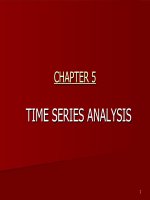Lecture Applied econometric time series (4e) - Chapter 4: Models with trend
Bạn đang xem bản rút gọn của tài liệu. Xem và tải ngay bản đầy đủ của tài liệu tại đây (787.16 KB, 42 trang )
Applied Econometric Time
Series 4th ed.
Walter Enders
Chapter 4
Walter Enders, University of Alabama
Copyright © 2015 John, Wiley & Sons, Inc. All rights reserved.
Copyright © 2015 John, Wiley & Sons, Inc. All rights reserved.
The Random Walk Model
yt = yt–1 + εt (or ∆yt = εt).
Hence
yt = y0 +
t
i =1
εi
Given the first t realizations of the {εt} process, the conditional mean of yt+1
is
Etyt+1 = Et(yt + εt+1) = yt
Similarly, the conditional mean of yt+s (for any s > 0) can be obtained from
Et yt + s = yt + Et
s
i =1
ε t +i = yt
var(yt) = var(εt + εt–1 + ... + ε1) = tσ2
var(yt–s) = var(εt–s + εt–s–1 + ... + ε1) = (t – s) σ
Copyright © 2015 John, Wiley & Sons, Inc. All rights reserved.
Random Walk Plus Drift
yt = yt–1 + a0 + εt
Given the initial condition y0, the general solution for yt is
yt = y 0 + a 0t +
t
i =1
εi
y t + s = y0 + a0 ( t + s ) +
t+s
i =1
εi
Etyt+s = yt + a0s.
Copyright © 2015 John, Wiley & Sons, Inc. All rights reserved.
The autocorrelation coefficient
E[(yt – y0)(yt–s – y0)] = E[(εt + εt–1+...+ ε1)(εt–s+ εt–s–1 +...+ε1)]
= E[(εt–s)2+(εt–s–1)2+...+(ε1)2]
= (t – s)σ2
ρ s = (t − s ) / (t − s )t
= [(t – s)/t]0.5
Hence, in using sample data, the autocorrelation function for a
random walk process will show a slight tendency to decay.
Copyright © 2015 John, Wiley & Sons, Inc. All rights reserved.
Panel (a): Random Walk
Panel (b): Random Walk Plus Drift
12
60
10
50
8
40
6
30
4
20
2
10
0
0
10
20
30
40
50
60
70
80
90
100
10
Panel (c): T rend Stationary
20
30
40
50
60
70
80
90
100
90
100
Panel (d): Random Walk Plus Noise
60
14
12
50
10
40
8
30
6
20
4
10
2
0
0
10
20
30
40
50
60
70
80
90
100
10
20
30
40
Figure 4.2: Four Series With Trends
Copyright © 2015 John, Wiley & Sons, Inc. All rights reserved.
50
60
70
80
Figure 4.3: The Business Cycle?
200
150
100
50
0
12
10
8
6
4
2
0
Copyright © 2015 John, Wiley & Sons, Inc. All rights reserved.
Table 4.1: Selected Autocorrelations From Nelson and
Plosser
1
2
r(1)
r(2)
d(1)
d(2)
Real GNP
.95
.90
.34
.04
.87
.66
Nominal GNP
.95
.89
.44
.08
.93
.79
Industrial Production
.97
.94
.03
.11
.84
.67
Unemployment
Rate
.75
.47
.09
.29
.75
.46
Copyright © 2015 John, Wiley & Sons, Inc. All rights reserved.
Worksheet 4.1
Consider the two random walk processes
yt = yt 1 + yt
10
zt = zt 1 + zt
5.0
8
2.5
6
0.0
4
2
-2.5
0
-5.0
-2
-4
-7.5
20
40
60
80
100
20
40
60
80
100
Since both series are unitroot processes with uncorrelated error terms, the regression of
yt on zt is spurious. Given the realizations of { yt} and { zt}, it happens that yt tends to increase as
zt tends to decrease. The regression line shown in the scatter plot of yt on zt captures this
tendency. The correlation coefficient between yt and zt is 0.69 and a linear regression yields yt =
1.41 0.565zt. However, the residuals from the regression equation are nonstationary.
Scatter Plot of yt Against zt
Regression Residuals
10
5
4
8
3
6
2
4
1
2
0
-1
0
-2
-2
-3
-4
-4
-7.5
-5.0
-2.5
0.0
2.5
5.0
10
20
30
40
50
60
70
80
90
100
Copyright © 2015 John, Wiley & Sons, Inc. All rights reserved.
Worksheet 4.2
Consider the two random walk plus drift processes
yt = 0.2 + yt 1 + yt
zt = 0.1 + zt 1 + zt
25
2.5
20
0.0
-2.5
15
-5.0
10
-7.5
5
-10.0
0
-12.5
-5
-15.0
10
20
30
40
50
60
70
80
90
100
10
20
30
40
50
60
70
80
90
100
Here {yt} and {zt} series are unitroot processes with uncorrelated error terms so that the regression is
spurious. Although it is the deterministic drift terms that cause the sustained increase in yt and the overall
decline in zt, it appears that the two series are inversely related to each other. The residuals from the
regression yt = 6.38 0.10zt are nonstationary.
Scatter Plot of yt Against zt
Regression Residuals
25
7.5
20
5.0
15
2.5
10
0.0
5
-2.5
0
-5.0
-5
-15.0
-7.5
-12.5
-10.0
-7.5
-5.0
-2.5
0.0
2.5
10
20
30
40
50
60
70
Copyright © 2015 John, Wiley & Sons, Inc. All rights reserved.
80
90
100
Panel (a): Detrended RGDP
1.00
0.75
0.50
0.25
0.00
-0.25
-0.50
0
1
2
3
4
5
6
7
8
9
10
11
12
10
11
12
Panel (b): Logarithm ic Change in RGDP
1.00
0.50
0.00
-0.50
0
1
2
3
4
5
6
Autocorrelations
7
8
PACF
Figure 4.4 ACF and PACF
Copyright © 2015 John, Wiley & Sons, Inc. All rights reserved.
9
3. UNIT ROOTS AND REGRESSION RESIDUALS
•
•
yt = a0 + a1zt + et
Assumptions of the classical model:
– both the {yt} and {zt} sequences be stationary
– the errors have a zero mean and a finite variance.
– In the presence of nonstationary variables, there might be
what Granger and Newbold (1974) call a spurious
regression
•
A spurious regression has a high R2 and tstatistics that
appear to be significant, but the results are without any
economic meaning.
•
The regression output “looks good” because the least
squares estimates are not consistent and the customary
tests of statistical inference do not hold.
Copyright © 2015 John, Wiley & Sons, Inc. All rights reserved.
Four cases
•
CASE 1: Both {yt} and {zt} are stationary.
–
•
CASE 2: The {yt} and {zt} sequences are integrated of different
orders.
–
•
Regression equations using such variables are meaningless
CASE 3: The nonstationary {yt} and {zt} sequences are integrated of
the same order and the residual sequence contains a stochastic trend.
–
–
•
the classical regression model is appropriate.
This is the case in which the regression is spurious.
In this case, it is often recommended that the regression equation be estimated in first
differences.
CASE 4: The nonstationary {yt} and {zt} sequences are integrated of
the same order and the residual sequence is stationary.
–
In this circumstance, {yt} and {zt} are cointegrated.
Copyright © 2015 John, Wiley & Sons, Inc. All rights reserved.
The DickeyFuller tests
Δyt = γ yt −1 +
p
i=2
β i ∆yt −i +1 + ε t
Δyt = a0 + γ yt −1 +
p
i =2
βi ∆yt −i +1 + ε t
Δyt = a0 + γ yt −1 + a2t +
p
i =2
βi ∆yt −i +1 + ε t
The φ1, φ2, and φ3 statistics are constructed in exactly the same
way as ordinary Ftests:
φi
SSR ( restricted ) − SSR (unrestricted )] / r
[
=
SSR(unrestricted ) /(T − k )
Copyright © 2015 John, Wiley & Sons, Inc. All rights reserved.
Figure 4.6: The Dickey-Fuller Distribution
12
10
8
percent ile
6
4
2
0
0
2
4
6
8
t -st at ist ic
Copyright © 2015 John, Wiley & Sons, Inc. All rights reserved.
10
12
Table 4.2: Summary of the DickeyFuller
Tests
Model
Hypothesis
yt = a0 + yt1 + a2t + t
= 0
3.45 and 4.04
= a2 = 0
3
6.49 and 8.73
a0 = = a2 = 0
2
4.88 and 6.50
2.89 and 3.51
1
4.71 and 6.70
1.95 and 2.60
yt = a0 + yt1 + t
yt = yt1 + t
= 0
a0 = = 0
= 0
Test
Statistic
Copyright © 2015 John, Wiley & Sons, Inc. All rights reserved.
Critical values for
95% and 99%
Confidence Intervals
Table 4.3: Nelson and Plosser's Tests For
Unit Roots
p
a0
a2
+ 1
Real GNP
2
0.819
0.006
0.175
0.825
(3.03)
(3.03)
(2.99)
1.06
0.006
0.101
0.899
(2.37)
(2.34)
(2.32)
0.103
0.007
0.165
0.835
(4.32)
(2.44)
(2.53)
0.513
0.000
0.294*
0.706
(2.81)
(0.23)
(3.55)
Nominal GNP
Industrial Production
Unemployment Rate
2
6
4
p is the chosen lag length. Entries in parentheses represent the t-test for
the null hypothesis that a coefficient is equal to zero. Under the null of
nonstationarity, it is necessary to use the Dickey-Fuller critical values. At
the .05 significance level, the critical value for the t-statistic is -3.45.
Copyright © 2015 John, Wiley & Sons, Inc. All rights reserved.
Quarterly Real U.S. GDP
lrgdpt = 0.1248 + 0.0001t 0.0156lrgdpt–1 +
0.3663 lrgdpt–1
(1.58)
(1.31)
( 1.49)
(6.26)
The tstatistic on the coefficient for lrgdpt–1 is 1.49. Table A
indicates that, with 244 usable observations, the 10% and 5% critical
value of are about 3.13 and 3.43, respectively. As such, we cannot
reject the null hypothesis of a unit root.
The sample value of 3 for the null hypothesis a2 = γ = 0 is 2.97. As
Table B indicates that the 10% critical value is 5.39, we cannot reject
the joint hypothesis of a unit root and no deterministic time trend. The
sample value of 2 is 20.20. Since the sample value of 2 (equal to
17.61) far exceeds the 5% critical value of 4.75, we do not want to
exclude the drift term. We can conclude that the growth rate of the real
GDP series acts as a random walk plus drift plus the irregular term
0.3663 lrgdpt–1.
Copyright © 2015 John, Wiley & Sons, Inc. All rights reserved.
Table 4.4: Real Exchange Rate Estimation
H0: = 0
Lags
Mean
0.022
(0.016)
0.047
(0.074)
0.027
(0.076)
t = 1.42
0
1.05
t = 0.64
2
1.01
t = 0.28
2
1.11
0.031
(0.019)
0.030
(0.028)
0.016
(0.012)
t = 1.59
0
1.02
t = 1.04
0
0.98
t = 1.23
0
1.01
/
DW
F
SD/
SEE
19731986
Canada
Japan
Germany
0.059 0.194
1.88
0.007 0.226
2.01
0.014 0.858
2.04
5.47
1.16
10.44
2.81
20.68
3.71
0.107 0.434
2.21
0.046 0.330
1.98
0.038 0.097
1.93
.014
.004
.017
.005
.026
.004
19601971
Canada
Japan
Germany
Copyright © 2015 John, Wiley & Sons, Inc. All rights reserved.
EXTENSIONS OF THE DICKEY–FULLER TEST
yt = a0 + a1yt–1 + a2yt–2 + a3yt–3 + ... + ap–2yt–p+2 + ap–1yt–p+1 + apyt–
p + εt
add and subtract apyt–p+1 to obtain
yt = a0 + a1yt–1 + a2yt–2 + ...+ ap–2yt–p+2 + (ap–1 + ap)yt–p+1 – ap∆yt–
p+1 + εt
Next, add and subtract (ap–1 + ap)yt–p+2 to obtain:
yt = a0 + a1yt–1 + a2yt–2 + a3yt–3 + ... – (ap–1 + ap)∆yt–p+2 – ap∆yt–p+1
+ εt
p
a0 + γ yt −we
βi ∆yt −i +1 + ε t
y t =fashion,
1 + obtain
Continuing in∆this
i= 2
�
γ = −�
1−
�
p
i =1
�
ai �
and β i = −
�
p
j =i
a j
Copyright © 2015 John, Wiley & Sons, Inc. All rights reserved.
Rule 1:
•
Consider a regression equation containing a mixture of I(1)
and I(0) variables such that the residuals are white noise. If
the model is such that the coefficient of interest can be
written as a coefficient on zeromean stationary variables,
then asymptotically, the OLS estimator converges to a
normal distribution. As such, a ttest is appropriate.
Copyright © 2015 John, Wiley & Sons, Inc. All rights reserved.
•
Rule 1 indicates that you can conduct lag length tests using t
tests and/or Ftests on
yt = yt–1 + 2 yt–1 + 3 yt–2 + … + p yt–p+1 + t
Copyright © 2015 John, Wiley & Sons, Inc. All rights reserved.
Selection of the Lag Length
•
•
•
generaltospecific methodology
– Start using a lag length of p*. If the tstatistic on lag p*
is insignificant at some specified critical value, re
estimate the regression using a lag length of p*–1.
Repeat the process until the last lag is significantly
different from zero.
– Once a tentative lag length has been determined,
diagnostic checking should be conducted.
Model Selection Criteria (AIC ,SBC)
Residualbased LM tests
Copyright © 2015 John, Wiley & Sons, Inc. All rights reserved.
The Test with MA Components
•
A(L)yt = C(L)εt so that A(L)/C(L)yt = εt
•
So that D(L)yt = εt
–
–
Even though D(L) will generally be an infinite
order polynomialwe can use the same technique
as used above to form the infiniteorder
autoregressive model
However, unit root tests generally work poorly
if the error process has a strongly negative MA
component.
Copyright © 2015 John, Wiley & Sons, Inc. All rights reserved.
Example of a Negative MA term
yt = yt1 + εt – β1εt1;
0 < β1 < 1.
The ACF is:
γ0 = E[(yt – y0)2] = σ2 + (1 – β1)2E[(εt1)2 + (εt2)2 + … + (ε1)2]
= [1 + (1 – β1)2(t – 1)]σ2
γs = E[(yt – y0)(yts – y0)]
= E[(εt +(1–β1)εt1 + … + (1–β1)ε1)(εts + (1–β1)εts1 + … + (1–
β1)ε1)
= (1 – β1) [1 + (1 – β1) (t – s – 1)] σ2
The ρi approach unity as the sample size t becomes infinitely large.
For the sample sizes usually found in applied work, the autocorrelations
can be small.
Let β1 be close to unity so that terms containing (1 – β1)2 can be safely
ignored. The ACF can be approximated by ρ1 = ρ2 = … = (1 – β1)0.5. For
example, if β1 = 0.95, all of the autocorrelations should be 0.22.
Copyright © 2015 John, Wiley & Sons, Inc. All rights reserved.









